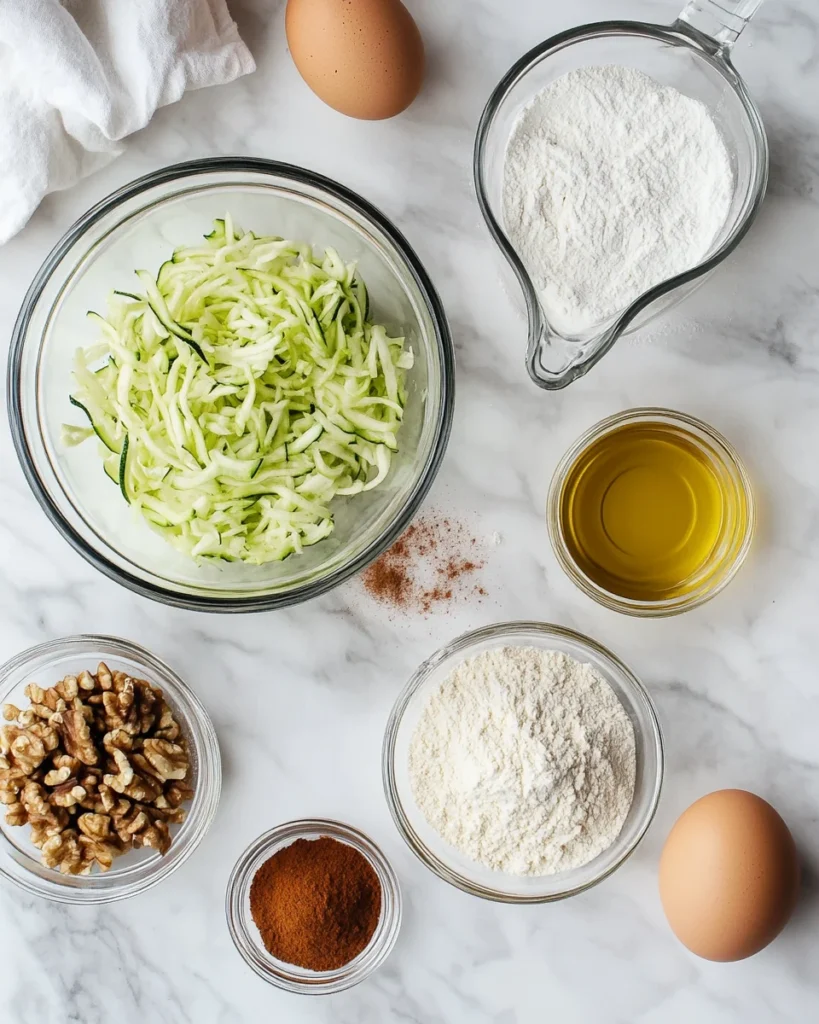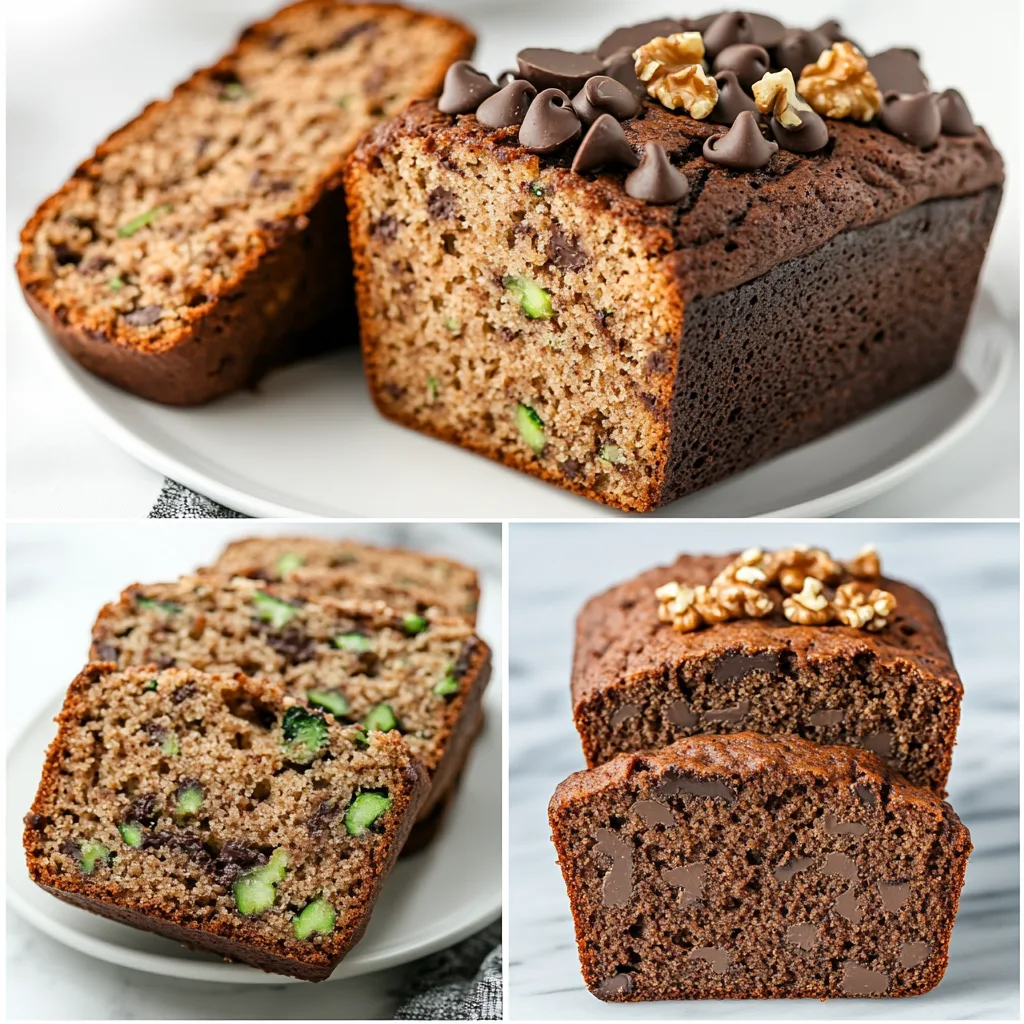Introduction
Biting into a fresh slice of zucchini bread only to be met with an unexpected bitterness can be disappointing. If you’ve ever wondered why this happens, you’re not alone. The good news? It’s completely fixable with the right ingredients and techniques.
Why Does Zucchini Bread Turn Bitter?
The culprit behind bitter zucchini bread is often cucurbitacins, natural compounds found in certain vegetables like zucchini, cucumbers, and squash. While commercially grown zucchini is usually mild, some factors—such as overripe zucchinis or improper preparation—can lead to a strong, unpleasant taste.
What You’ll Learn in This Recipe
In this guide, you’ll discover:
✔️ How to choose the right zucchini to avoid bitterness.
✔️ Simple baking tricks to enhance flavor and texture.
✔️ How to balance sweetness and moisture for a perfect loaf.
✔️ Common mistakes and how to avoid them.
Did you know? Overmixing your batter can make your zucchini bread dense instead of fluffy! In this recipe, we’ll show you the best mixing technique for a perfectly light texture.
Bitter Zucchini Bread? Key Benefits of This Perfect Recipe

A great zucchini bread should be moist, flavorful, and never bitter. This recipe ensures the perfect balance of sweetness, texture, and moisture while eliminating any unwanted bitterness. Here’s why you’ll love it:
✔ Naturally Sweet and Balanced
Bitterness can ruin a good zucchini bread, but this recipe includes the right sweeteners and flavor enhancers to create a smooth, pleasant taste. Brown sugar, honey, or maple syrup help neutralize any lingering bitterness, while cinnamon and vanilla extract add warmth and depth.
✔ Foolproof Moisture Control
Zucchini contains a high amount of water, which can make baked goods soggy or unevenly textured. This recipe ensures proper moisture balance by using the right draining techniques and a precise ratio of dry to wet ingredients, resulting in a perfectly tender loaf.
✔ Light, Fluffy Texture
Many zucchini bread recipes turn out too dense or gummy due to overmixing or incorrect flour measurements. This version uses a gentle folding technique and just the right amount of leavening agents (baking soda and baking powder) to keep the texture soft and airy.
✔ Simple, No-Fail Method
Even if you’re not an experienced baker, this recipe is straightforward and easy to follow. No fancy equipment required—just a bowl, a whisk, and a baking pan. Every step is designed to be fail-proof, making it perfect for both beginners and seasoned bakers.
✔ Versatile and Customizable
Want to make it healthier? Swap out refined sugar for natural sweeteners or go gluten-free by using almond or oat flour. Looking for extra flavor? Add chocolate chips, walnuts, or shredded coconut for a delicious twist.
✔ A Great Way to Use Zucchini
If you have an abundance of zucchini, this recipe is the perfect way to use it up. It’s an excellent snack, breakfast option, or even a dessert when served with a touch of butter or cream cheese.
Bitter Zucchini Bread? The Perfect Ingredients for a Balanced Loaf

The secret to avoiding bitter zucchini bread starts with selecting the right ingredients. Each component in this recipe is chosen to enhance flavor, texture, and moisture while ensuring your loaf turns out perfectly balanced.
✔ Zucchini: The Star Ingredient
- Choose young, small to medium zucchini – They have a mild, sweet taste compared to larger, overgrown ones, which tend to be bitter.
- Peel if necessary – Most bitterness comes from the skin, so if you detect a strong taste, peeling can help.
- Grate and drain properly – Excess moisture can make the bread too dense or gummy. Lightly squeezing grated zucchini removes just enough water without drying it out.
✔ Sweeteners to Balance Bitterness
- Brown sugar – Adds a hint of molasses for warmth and depth.
- Honey or maple syrup (optional) – Natural sweeteners enhance flavor while keeping the loaf moist.
- Granulated sugar – Provides structure and ensures a balanced sweetness.
✔ Dry Ingredients for the Perfect Texture
- All-purpose flour – The best base for a soft, tender crumb. Whole wheat flour can be used for a heartier version.
- Baking soda & baking powder – The right leavening agents prevent a dense texture.
- Cinnamon & nutmeg – These spices complement zucchini’s mild flavor and enhance sweetness naturally.
- Salt – A small amount enhances all the flavors without overpowering them.
✔ Wet Ingredients for Moisture & Flavor
- Eggs – Help bind ingredients and create a fluffy texture.
- Vegetable oil or melted butter – Oil keeps the bread ultra-moist, while butter adds richness.
- Vanilla extract – Balances flavors and enhances the overall aroma.
✔ Optional Add-ins for Extra Flavor & Crunch
- Chopped walnuts or pecans – Add crunch and depth of flavor.
- Chocolate chips – Perfect for a sweeter twist.
- Shredded coconut or raisins – Bring a natural sweetness that complements the zucchini.
Bitter Zucchini Bread? Step-by-Step Instructions for a Perfect Loaf
Now that you have the right ingredients, let’s go through the exact steps to bake a moist, flavorful, and non-bitter zucchini bread. Follow this simple method for the best results.
Step 1: Prepare the Zucchini
✔ Select fresh zucchini – Use small to medium-sized zucchinis to avoid bitterness.
✔ Grate the zucchini finely – A box grater or food processor works best.
✔ Drain excess moisture – Lightly squeeze the grated zucchini using a clean kitchen towel or paper towel. Do not remove all moisture—just enough to prevent sogginess.
Step 2: Preheat the Oven & Prepare the Pan
✔ Preheat oven to 175°C (350°F) – This ensures even baking.
✔ Grease a 9×5-inch loaf pan – Use butter or non-stick spray. You can also line it with parchment paper for easy removal.
Step 3: Mix the Dry Ingredients
✔ In a large bowl, whisk together:
- 2 cups all-purpose flour
- 1 teaspoon baking soda
- ½ teaspoon baking powder
- ½ teaspoon salt
- 1 teaspoon cinnamon
- ½ teaspoon nutmeg (optional)
Step 4: Mix the Wet Ingredients
✔ In another bowl, whisk together:
- 2 large eggs (room temperature)
- ¾ cup brown sugar
- ½ cup vegetable oil (or melted butter)
- 1 teaspoon vanilla extract
✔ Stir in the grated and drained zucchini until well combined.
Step 5: Combine Wet and Dry Mixtures
✔ Gradually add the dry ingredients to the wet mixture.
✔ Gently fold the batter using a spatula—do not overmix, as this can make the bread dense.
✔ If adding nuts, chocolate chips, or raisins, fold them in at this stage.
Step 6: Bake to Perfection
✔ Pour the batter into the greased loaf pan and smooth the top.
✔ Bake for 50-55 minutes, or until a toothpick inserted into the center comes out clean.
✔ Cool in the pan for 10 minutes, then transfer to a wire rack to cool completely.
Step 7: Slice and Enjoy!
Once fully cooled, slice your perfect zucchini bread and enjoy it as a snack, breakfast, or dessert.
Bitter Zucchini Bread? Pro Tips and Variations for the Perfect Loaf

Even with the best recipe, small adjustments can take your zucchini bread from good to absolutely perfect. Here are expert tips and delicious variations to make this loaf moist, flavorful, and never bitter.
✔ Pro Tips for the Best Zucchini Bread
1. Prevent Bitterness at the Source
- Choose the right zucchini – Small to medium-sized zucchinis are milder and naturally sweeter.
- Peel if necessary – If the skin tastes bitter, peeling can help reduce unpleasant flavors.
- Avoid overripe zucchini – Overgrown zucchini tends to be watery and bitter.
2. Control Moisture for the Perfect Texture
- Don’t skip draining – Lightly squeeze grated zucchini to remove excess moisture, but don’t dry it out completely.
- Measure flour correctly – Use the spoon-and-level method to avoid dense, dry bread.
- Use oil instead of butter – Oil helps keep the bread soft and moist for days.
3. Enhance Flavor with the Right Ingredients
- Brown sugar adds a deeper caramel-like sweetness that balances any slight bitterness.
- A splash of lemon juice can brighten the flavor and mask bitterness.
- Spices like cinnamon and nutmeg naturally complement zucchini’s mild taste.
4. Avoid Overmixing the Batter
- Stir until ingredients are just combined—overmixing leads to a dense, chewy texture instead of a light, fluffy loaf.
5. Check for Doneness the Right Way
- Insert a toothpick into the center—if it comes out clean or with a few crumbs, it’s ready.
- Let it cool completely before slicing to prevent crumbling.
✔ Delicious Variations to Try
1. Gluten-Free Zucchini Bread
- Swap all-purpose flour for a gluten-free baking blend (1:1 ratio).
- Add an extra egg for better structure and moisture.
2. Healthier Zucchini Bread
- Use whole wheat flour instead of all-purpose for added fiber.
- Replace sugar with honey or maple syrup for natural sweetness.
- Substitute applesauce for oil to cut down on fat while keeping it moist.
3. Chocolate Chip Zucchini Bread
- Stir in ½ cup dark chocolate chips for a sweet, rich twist.
- Sprinkle extra chocolate chips on top before baking for a gooey finish.
4. Nutty Zucchini Bread
- Add ½ cup chopped walnuts or pecans for a crunchy texture.
- Toast the nuts beforehand for extra depth of flavor.
5. Tropical Zucchini Bread
- Stir in shredded coconut for a slightly sweet, nutty flavor.
- Add ½ cup crushed pineapple (drained) for extra moisture.
With these pro tips and variations, you can customize your zucchini bread to match your taste and dietary needs. Now, let’s move on to the best ways to serve and enjoy your loaf!
Bitter Zucchini Bread? Serving Suggestions for the Best Experience
Now that you’ve baked the perfect bitter-free zucchini bread, let’s explore the best ways to serve and enjoy it. Whether you like it warm, toasted, or paired with complementary flavors, these serving ideas will enhance every bite.
✔ Best Ways to Serve Zucchini Bread
1. Classic & Warm
- Serve a freshly baked slice while it’s still warm. The soft texture and rich aroma make it irresistible straight out of the oven.
- Add a small pat of butter on top—it melts into the bread, enhancing the flavor.
2. Toasted for Extra Crunch
- Slice and toast it lightly in a pan or toaster oven for a crispy edge and warm center.
- Spread with cream cheese, peanut butter, or almond butter for added richness.
3. Drizzled with Sweet Additions
- A light drizzle of honey or maple syrup brings out the bread’s natural sweetness.
- For a dessert-style treat, add a dusting of powdered sugar or a drizzle of warm chocolate sauce.
4. Pair It with Beverages
- Enjoy with a hot cup of coffee, tea, or chai—the warm spices in the bread pair perfectly with these drinks.
- Serve with cold milk or a spiced latte for a cozy, comforting combination.
5. Transform It into a Dessert
- Top with a scoop of vanilla or cinnamon ice cream for a simple yet indulgent dessert.
- Use it as a base for zucchini bread French toast by dipping slices in a cinnamon-vanilla egg mixture and pan-frying until golden.
✔ Storing & Freezing for Freshness
Short-Term Storage (Up to 4 Days)
- Keep zucchini bread in an airtight container at room temperature for up to 3-4 days.
- Wrap it in plastic wrap or foil to prevent drying out.
Refrigeration (Up to 1 Week)
- For longer freshness, store in the fridge in an airtight container.
- Let it come to room temperature or warm it slightly before serving.
Freezing (Up to 3 Months)
- Wrap slices individually in plastic wrap, then place them in a freezer-safe bag.
- Thaw at room temperature or microwave for 20-30 seconds for a quick, warm treat.

Bitter Zucchini Bread? Conclusion and Final Thoughts
Baking zucchini bread should be a delicious and rewarding experience, not one filled with unexpected bitterness. By following this foolproof recipe, you’ve learned how to:
✔ Select the right zucchini to avoid bitterness.
✔ Balance flavors with the right mix of sweeteners and spices.
✔ Control moisture for a soft, perfectly textured loaf.
✔ Use expert baking tips to ensure success every time.
✔ Customize your bread with creative add-ins and variations.
✔ Serve it in the best ways to maximize flavor and enjoyment.
Final Takeaway: How to Avoid Bitter Zucchini Bread for Good
If you ever find yourself dealing with a bitter loaf again, remember these key tips:
- Always choose small, young zucchini for baking.
- Peel the skin if the zucchini tastes too bitter.
- Balance flavors with sweeteners, spices, and vanilla extract.
- Never overmix your batter—gentle folding keeps it light and fluffy.
- Bake at the right temperature and don’t skip cooling time.
With this recipe and these simple adjustments, your zucchini bread will always turn out moist, flavorful, and never bitter.
Bitter Zucchini Bread? FAQs and Expert Answers
If you’ve ever had bitter zucchini bread, you’re not alone. Below are answers to common questions to help you troubleshoot and perfect your recipe.
Past Your Questions Here
Why does my zucchini bread taste bitter?
Bitter zucchini bread is usually caused by cucurbitacins, natural compounds found in some zucchinis. Overripe or improperly stored zucchini may have a stronger bitter taste. Using young, fresh zucchini and peeling the skin can help eliminate bitterness.
How can I make zucchini bread sweeter without adding more sugar?
To enhance natural sweetness without extra sugar, try adding:
- Mashed banana or applesauce for a mild, fruity sweetness.
- Maple syrup or honey as a natural alternative.
- Cinnamon, nutmeg, or vanilla extract to bring out depth of flavor.
Should I peel the zucchini before making bread?
Peeling is optional but recommended if the zucchini tastes bitter. If the skin is mild, you can leave it on for extra nutrients and color in your bread.
How do I keep zucchini bread from being too dense?
A dense loaf is often caused by overmixing the batter or too much moisture. To avoid this:
- Gently fold the batter until just combined—don’t overmix.
- Squeeze excess water from grated zucchini to maintain the right moisture balance.
- Measure flour properly using the spoon-and-level method to prevent adding too much.
Can I make zucchini bread without eggs?
Yes! Try these egg substitutes for a vegan-friendly version:
- 1 tablespoon flaxseed meal + 3 tablespoons water (per egg)
- ½ mashed banana (adds natural sweetness)
- ¼ cup unsweetened applesauce
How long does zucchini bread stay fresh?
- Room temperature: 3-4 days in an airtight container.
- Refrigerated: Up to a week, wrapped tightly.
- Frozen: Up to 3 months when individually wrapped and stored in a freezer-safe bag.
Can I make gluten-free zucchini bread?
Yes! Swap the all-purpose flour for a 1:1 gluten-free flour blend or use almond or oat flour for a denser, nutty texture.
By following these expert tips, you can enjoy moist, perfectly sweetened zucchini bread—without any bitterness!
Now that you have all the answers, it’s time to bake the perfect loaf and enjoy every bite!

